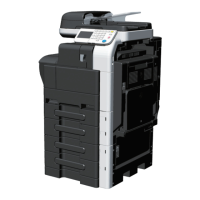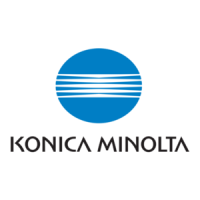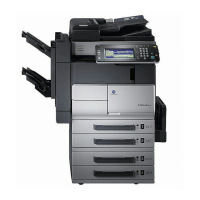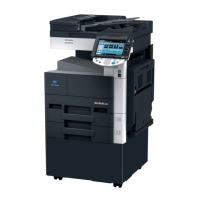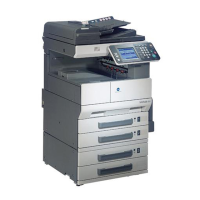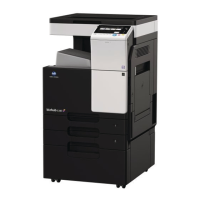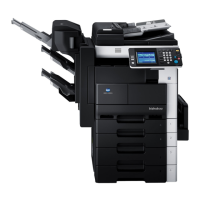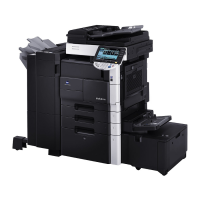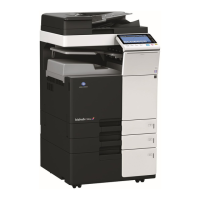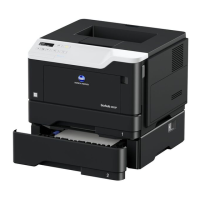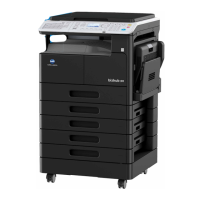What to do if my Konica Minolta printer says 'Scanner disabled by admin'?
- KkathrynjohnsonSep 13, 2025
If your Konica Minolta printer displays 'Scanner disabled by admin', print without the scanner, or contact your system support person.
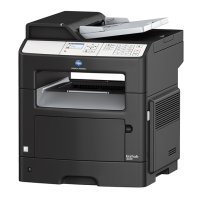
What to do if my Konica Minolta printer says 'Scanner disabled by admin'?
If your Konica Minolta printer displays 'Scanner disabled by admin', print without the scanner, or contact your system support person.
What to do if my Konica Minolta Printer says 'Change [paper source] to [custom string] load [paper orientation]'?
When your Konica Minolta printer prompts you to 'Change [paper source] to [custom string] load [paper orientation]', load the correct size and type of paper in the tray. Next, verify that the paper size and type settings are correctly specified in the Paper menu on the printer control panel. Finally, select 'Finished changing paper'.
What does 'Cartridge low' mean on my Konica Minolta printer?
If your Konica Minolta printer displays a 'Cartridge low' message, it indicates that you may need to order a toner cartridge soon.
What does 'Imaging unit low' mean on my Konica Minolta printer?
If your Konica Minolta printer displays an 'Imaging unit low' message, it means that you may need to order a new imaging unit.
What to do if my Konica Minolta printer says 'Cartridge nearly low'?
If your Konica Minolta printer displays a 'Cartridge nearly low' message, you can select 'Continue' on the printer control panel to clear the message and continue printing, if necessary.
What to do if my Konica Minolta printer says 'Remove paper from standard output bin'?
If your Konica Minolta printer displays a 'Remove paper from standard output bin' message, remove the paper stack from the standard bin.
What to do if my Konica Minolta Printer says 'Printer had to restart. Last job may be incomplete'?
If your Konica Minolta printer displays 'Printer had to restart. Last job may be incomplete', touch the screen to clear the message and continue printing.
What to do if my Konica Minolta printer displays 'Replace cartridge, printer region mismatch'?
If your Konica Minolta printer displays a 'Replace cartridge, printer region mismatch' message, install a toner cartridge that matches the region number of the printer.
What to do if my Konica Minolta printer displays 'Insufficient memory for Flash Memory Defragment operation'?
If your Konica Minolta printer displays the message 'Insufficient memory for Flash Memory Defragment operation', delete fonts, macros, and other data from the printer memory.
What to do if my Konica Minolta Printer displays 'Error reading USB hub'?
If your Konica Minolta printer shows 'Error reading USB hub. Remove hub', it means that an unsupported USB hub has been inserted. Remove the USB hub, and then install a supported one.
| Print Speed | 33 ppm |
|---|---|
| Print Resolution | 1200 x 1200 dpi |
| Scan Resolution | 600 x 600 dpi |
| Duplex Printing | Yes |
| Functions | Print, Copy, Scan, Fax |
| Print Technology | Laser |
| Maximum Paper Size | A4 |
| Scanner Type | Flatbed with ADF |
| Automatic Document Feeder (ADF) | Yes, 50 sheets |
| Fax Speed | 33.6 Kbps |
| Monthly Duty Cycle | 50, 000 pages |
| Copy Speed | 33 cpm |
| Copy Resolution | 600 x 600 dpi |
| Operating System Compatibility | Windows, Mac, Linux |
| Connectivity | USB, Ethernet |
| Paper Capacity | 250 sheets |
Guides for locating printer information, including setup and supplemental resources.
Details on choosing an appropriate environment and placement for the printer.
Information on configuring the printer, including optional trays and setup.
Overview of scanner capabilities and how to use the ADF and scanner glass.
Instructions for loading and scanning documents using the Automatic Document Feeder (ADF).
Instructions for placing and scanning documents on the printer's scanner glass.
Details on the function and use of each button on the printer's control panel.
Explanation of printer status indicated by control panel lights and their meanings.
Details on installing memory cards, font cards, and network interface cards.
Instructions for installing optional hardware components, including order of installation.
Step-by-step guide for installing optional paper trays.
Instructions for connecting USB and Ethernet cables for printer operation.
Procedures for installing printer drivers for Windows and Macintosh operating systems.
Procedures for installing printer drivers for Windows and Macintosh operating systems.
How to manually add installed hardware options to the printer driver.
Information and steps for network configuration.
Information needed and steps to configure the printer for an Ethernet network connection.
Instructions for installing the printer on an Ethernet network for Windows and Macintosh users.
Steps for adding the printer using the printer configuration utility for Linux.
Instructions for adding the printer via the CUPS Administration Web page.
Information required and prerequisites for setting up a wireless printer connection.
Steps to connect the printer to a wireless network using the Wireless Setup Wizard.
Procedures for connecting to a wireless network using WPS Push Button or PIN methods.
Steps to connect the printer to a wireless network via the Embedded Web Server.
Methods to verify correct printer and software installation using menu settings and network pages.
Instructions for configuring the printer's paper size and type settings.
Setting up custom paper sizes for printing on non-standard paper dimensions.
Detailed steps for correctly loading paper into the printer's paper trays.
Instructions for loading paper and specialty media into the printer's multipurpose feeder.
Information on how printer trays automatically feed paper and how to manage tray linking.
Steps to create custom paper type names using the Embedded Web Server or control panel.
Guidelines for selecting and handling paper for optimal print quality and reliability.
List of paper types and conditions that are not recommended for use with the printer.
Tables detailing supported paper sizes, types, and their compatibility with different printer components.
Tips for using letterhead, transparencies, envelopes, labels, and card stock with the printer.
Instructions for printing documents from Windows and Macintosh operating systems.
How to adjust the toner darkness using the Embedded Web Server or printer control panel.
Procedures for storing, printing, and managing confidential or held print jobs.
Options for configuring settings related to confidential print jobs, like PIN attempts and expiration.
How to print font sample lists for checking printer font support.
Methods for canceling print jobs from the printer control panel or a computer.
Basic procedures for making copies using the ADF or scanner glass.
Instructions for making copies using the Automatic Document Feeder (ADF).
Instructions for making copies using the printer's scanner glass.
Steps for copying photographs, including setting content type and source.
Guidance on copying transparencies and letterhead using ADF or multipurpose feeder.
Adjusting copy settings, including copying to different paper sizes.
Instructions for selecting specific trays for making copies and loading paper.
How to perform two-sided copying using the ADF or scanner glass.
Scaling options for copies, allowing adjustments from 25% to 400% of original size.
Adjusting the darkness setting for copies to achieve desired print output.
Settings to improve copy quality, such as content type and content source.
Options for arranging multiple copies into sets or groups of pages.
Using separator sheets to organize copies between pages, jobs, or copies.
Saving paper by printing multiple pages on one side of a single sheet.
Adding overlay messages to copies, such as Confidential or Draft watermarks.
Procedure to cancel a copy job from the printer's control panel.
Explanation of copy options like Copies, Copy from, Copy to, Scale, Darkness, Sides, Collate.
Configuration steps for enabling and setting up the printer's e-mail functionality.
Adjusting settings related to e-mail server configuration for sending scanned documents.
Steps to create shortcuts for sending e-mails to specific recipients via the Embedded Web Server.
Methods for sending scanned documents via e-mail using shortcut numbers or the address book.
Procedure to cancel an ongoing e-mail job from the printer control panel.
Initial setup and connection requirements for using the printer's fax capabilities.
Entering required fax information like station name and number for outgoing faxes.
Configuring fax settings directly through the printer's control panel interface.
Configuring fax settings using the printer's Embedded Web Server via a web browser.
Scenarios and diagrams for connecting the printer to different telephone line types.
Connecting the printer to a line shared with voice mail, including tips for proper setup.
Instructions for connecting the printer to a DSL line using a DSL filter for optimal connection.
Diagrams and steps for connecting the printer to a VoIP telephone service line.
Steps for connecting the printer to a cable modem's telephone service for faxing.
Information on compatibility with different telephone wall jacks and the need for adapters.
Instructions for connecting the printer to telephone systems that use non-RJ-11 wall jacks.
Specific connection instructions for German telephone wall jacks (N and F ports).
Setting up the printer to answer calls based on different ring patterns for fax and voice.
Configuring the name and number that appear on outgoing faxes.
How to set the printer's date and time for accurate fax transmission records.
Enabling automatic adjustment for daylight saving time based on the printer's time zone.
Instructions for sending faxes using the printer control panel or a computer.
Using fax shortcuts for quick dialing of frequently used fax numbers.
Using the address book to search for and send faxes to stored recipients.
Setting a specific date and time for the printer to send a fax job.
Assigning shortcut numbers to fax numbers or groups via the Embedded Web Server.
Adjusting fax resolution, darkness, and other settings for outgoing faxes.
Accessing and reviewing the fax job log and call log for transmission history.
Options for blocking incoming faxes from specific callers or those with no caller ID.
Steps to cancel an outgoing fax job during or after scanning.
Features for holding received faxes until released or forwarding them to other destinations.
Explanation of fax options like Original Size, Resolution, Darkness, and Content Type.
Instructions for scanning documents directly to an FTP server.
Setting up shortcuts for FTP destinations via the Embedded Web Server.
Scanning documents to an FTP address using pre-configured shortcut numbers.
Scanning documents to an FTP address by selecting recipients from the address book.
Steps for scanning documents directly to a computer over the network.
Overview of the printer's menu structure, including Paper, Reports, Network/Ports, Security, and Settings.
Details on printer settings related to paper selection, size, type, and loading.
Options for printing various reports like menu settings, device statistics, and network status.
Configuration settings for network and port connections, including Active NIC and network protocols.
Settings related to printer security, including audit logs and user access.
General configuration options for the printer, such as display language, eco-mode, and paper size units.
Suggestions for reducing paper and toner consumption, including using recycled paper and duplex printing.
Information on using Eco-Mode and adjusting printer settings to reduce energy consumption.
Configuring the printer's sleep mode timeout to save energy during inactivity.
Information on the ultra-low-power Hibernate mode and how to enter it.
Steps to adjust the printer display's brightness for better visibility or energy saving.
Scheduling the printer's power states (e.g., reduced power, ready state) for energy efficiency.
Information about the types of memory in the printer and the data they store.
How to erase volatile memory by simply turning off the printer.
Procedures for erasing non-volatile memory, including wiping all settings.
Instructions for cleaning the exterior of the printer and its parts.
How to clean the scanner glass to resolve print quality issues like streaks.
Methods for checking the status of printer parts and supplies on the control panel or via Web Server.
Information on how the estimated number of remaining pages is calculated and its accuracy.
Information on ordering replacement printer supplies and parts.
Part numbers for ordering toner cartridges for different regions.
Information on maintenance kits and when they might need replacement.
Guidelines for storing printer supplies in a cool, clean environment.
Instructions for replacing consumables like toner cartridges and imaging units.
Step-by-step instructions for removing and replacing the toner cartridge.
Instructions for removing and replacing the printer's imaging unit.
Safety precautions and steps for moving the printer.
Precautions for safely moving the printer and its hardware options to a new location.
Guidance on accessing administrative tasks via the Embedded Web Server.
How to view the virtual display on the screen for status monitoring.
Configuring the printer to send email notifications for low supplies or paper jams.
Accessing printer status and performance reports through the Embedded Web Server.
Setting up selectable alerts for low supply conditions via email or on-screen notifications.
Procedures for resetting printer settings to their original factory defaults.
Tips and techniques for properly loading paper to prevent jams and misfeeds.
Interpreting jam messages and identifying locations to clear paper jams.
Instructions for clearing paper jams that occur when the front door needs to be opened.
Steps for clearing paper jams that require opening the rear door of the printer.
Procedure for clearing paper jams located in the printer's standard output bin.
Clearing paper jams related to duplex printing by removing and clearing Tray 1.
Instructions for clearing paper jams by opening and accessing specific paper trays.
Steps for clearing paper jams from the printer's manual feed area.
Clearing paper jams by opening the top cover of the automatic document feeder.
Interpreting common printer error and status messages for troubleshooting.
Guidance for resolving common printer issues like non-responsiveness and incorrect characters.
Troubleshooting steps for when the printer is not responding.
Diagnosing issues related to hardware components and installed internal options.
Troubleshooting steps for issues like jammed pages, paper jams, and incorrect paper handling.
Troubleshooting common printing issues like incorrect characters or wrong paper usage.
Resolving issues where incorrect characters appear on printed documents.
Troubleshooting why jobs print from incorrect trays or use the wrong paper type.
Steps to resolve issues where large print jobs fail to collate pages correctly.
Troubleshooting steps for printing PDF files that contain multiple languages or complex font embedding.
Step-by-step guide to diagnose why print jobs are not being processed by the printer.
Identifying factors that cause print jobs to take longer than usual and how to optimize speed.
Reasons why printer speed may decrease and how to address them.
Troubleshooting issues where printer trays fail to link automatically for paper feeding.
Adjusting print timeout settings to prevent unwanted page breaks in documents.
Troubleshooting print quality issues like jagged characters, clipped images, or voids.
Resolving issues with jagged or uneven character edges in printed output.
Troubleshooting why pages or images are clipped or cut off in the print output.
Addressing issues where images appear compressed on the printed output.
Resolving unwanted gray backgrounds or shading appearing on printed pages.
Troubleshooting horizontal lines or voids that appear on printed documents.
Adjusting settings to correct incorrect or uneven margins on printed pages.
Steps to resolve issues with paper curling after printing.
Troubleshooting general print quality issues like uneven density or texture.
Adjusting settings to reduce print darkness and conserve toner.
Troubleshooting steps to increase print lightness and improve toner density.
Steps to resolve the issue of the printer outputting blank pages.
Troubleshooting steps when the printer outputting solid black pages.
Identifying and resolving repeating defects that appear at consistent intervals on prints.
Troubleshooting steps for when faint shadow images appear on printed documents.
Resolving issues where printed output is skewed or not aligned properly on the page.
Troubleshooting steps for removing streaked horizontal lines from printed output.
Resolving issues with streaked vertical lines appearing on printed pages.
Troubleshooting unwanted toner fog or background shading on printed documents.
Steps to resolve issues where toner rubs off from the printed page.
Troubleshooting steps for poor print quality when using transparency media.
Resolving issues with uneven print density across the printed page.
Troubleshooting vertical voids or gaps that appear in printed output.
Troubleshooting common issues encountered with the printer's copying functions.
Troubleshooting steps when the copier function of the printer is unresponsive.
Steps to resolve issues where the scanner unit fails to close properly.
Diagnosing and fixing issues related to poor copy quality, such as dark marks or faded text.
Troubleshooting partial copies resulting from incorrect document placement or settings.
Troubleshooting common issues encountered with the printer's fax functions.
Steps to set up and enable the printer's fax function, including cable checks.
Troubleshooting steps when Caller ID information is not displayed for incoming calls.
Comprehensive troubleshooting guide for issues preventing sending or receiving faxes.
Resolving issues where the printer can send faxes but cannot receive them.
Troubleshooting steps when the printer can receive faxes but cannot send them.
Addressing issues with poor print quality on received faxes, potentially due to line or sender issues.
Troubleshooting common issues encountered with the printer's scanner functions.
Troubleshooting steps when the printer's scanner is not responding.
Resolving issues that prevent a scan job from completing successfully.
Steps to resolve issues where the scanner unit fails to close properly.
Troubleshooting slow scanning performance or computer freezing during scan operations.
Diagnosing and fixing issues related to poor quality scanned images.
Troubleshooting steps when the printer's Embedded Web Server is inaccessible.
Information on how to contact technical support and what details to provide.
Legal notice regarding copyright and reproduction rights for the manual.
Disclaimer regarding changes to the guide and equipment without prior notice.
List of trademarks and registered trademarks associated with the printer and software.
Terms and conditions governing the use of the printer's software and accompanying materials.
Measurements of sound pressure levels for different printer operating modes.
Specifications for ambient operating, shipping, and storage temperatures.
Disposal instructions and compliance information for EU member states.
Guidelines for proper disposal of the printer and supplies, consulting local authorities.
Information about the printer meeting ENERGY STAR guidelines for energy efficiency.
Table detailing the power consumption characteristics of the printer in various modes.
Explanation of the energy-saving Sleep Mode and its timeout settings.
Information on the ultra-low-power Hibernate mode and how to enter it.
FCC compliance information, REN, and connection requirements for US telephone networks.
Technical specifications and safety recommendations for the Canadian telephone network.
Special conditions and compliance information for connecting to the New Zealand telephone network.
Requirements for using the product in Switzerland, including a billing tone filter.
Information about modular components included in wireless-equipped models.
Regulatory notice for users in Brazil regarding interference and system operation.
RF notice statement from Taiwan's NCC for wireless equipment.
